不多说,直接上干货!
Hue配置文件里,提及到,提供有postgresql_psycopg2, mysql, sqlite3 or oracle。
注意:Hue本身用到的是sqlite3。
在哪里呢,怎么看呢?
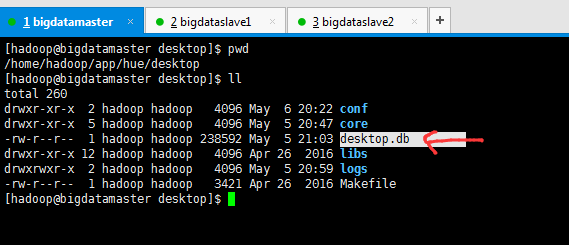
desktop.db这个就是Hue用的 sqlite3数据库。
https://www.cloudera.com/documentation/enterprise/latest/topics/cdh_ig_hue_config.html#concept_ezg_b2s_hl
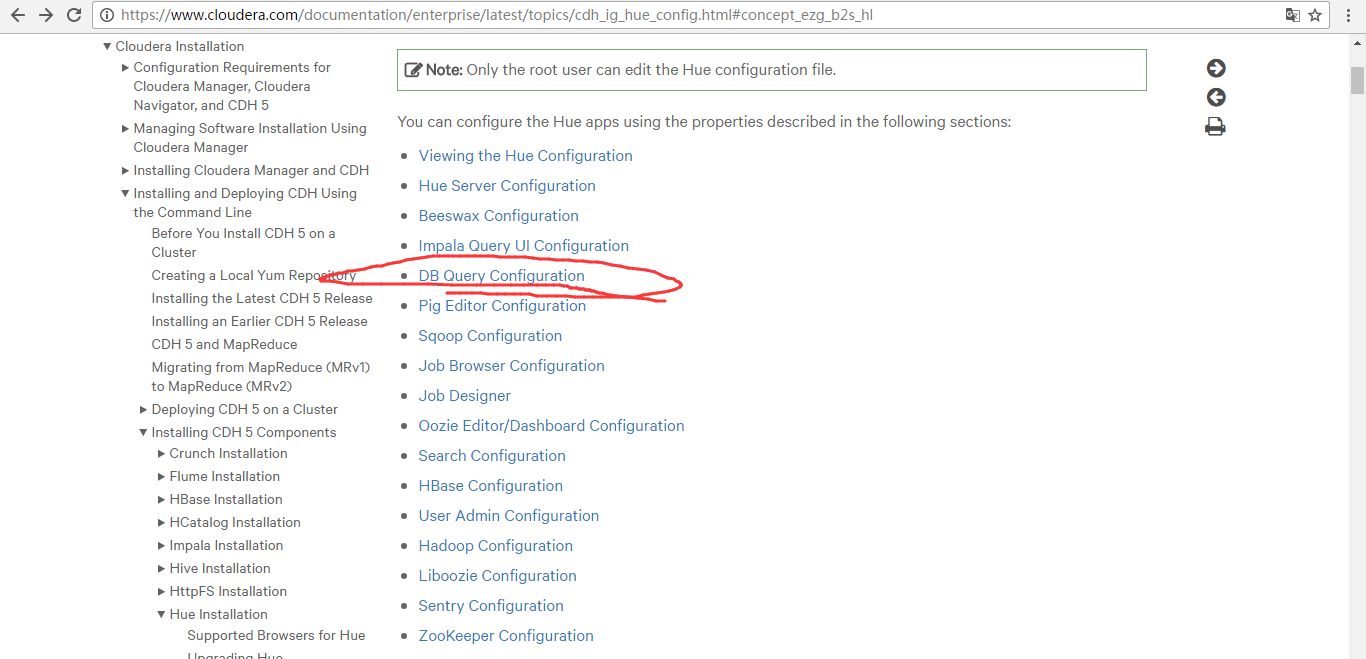
首先,看下官网的参考步骤
http://archive.cloudera.com/cdh5/cdh/5/hue-3.9.0-cdh5.5.0/manual.html
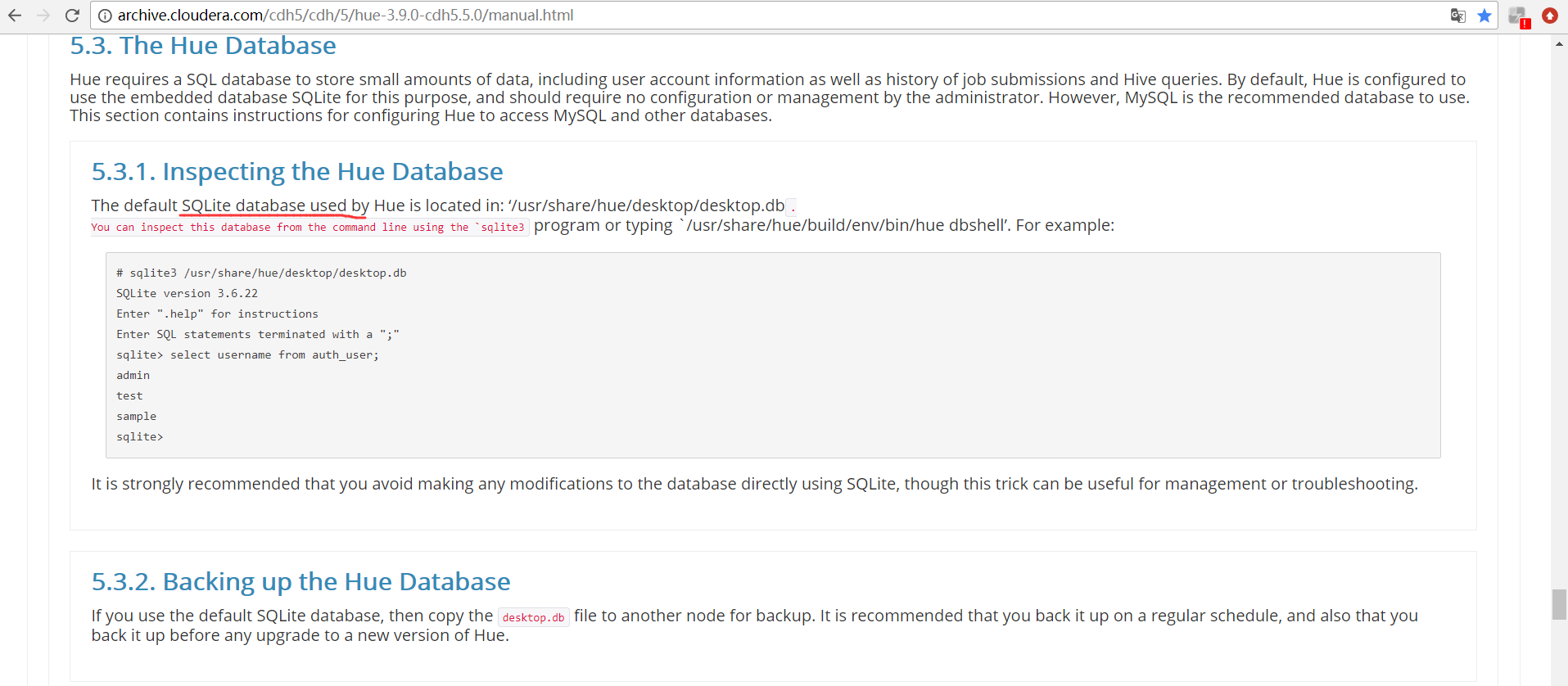
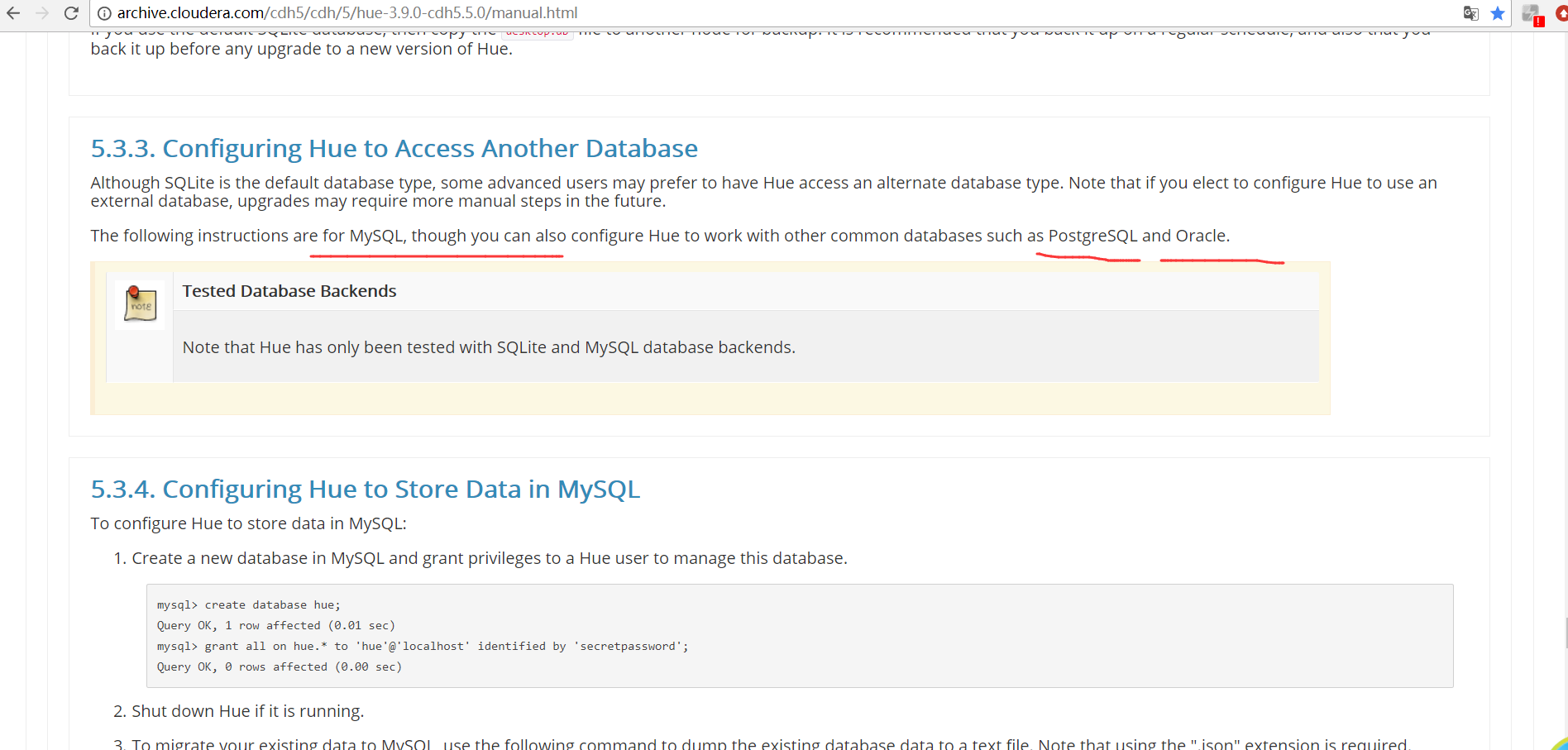
一、以下是默认的配置文件
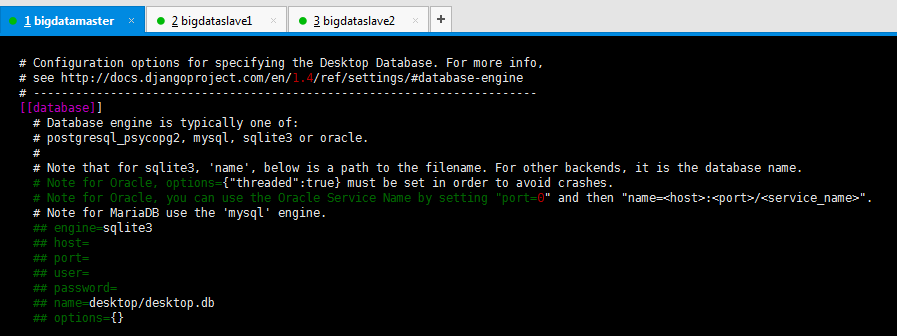

# Configuration options for specifying the Desktop Database. For more info, # see http://docs.djangoproject.com/en/1.4/ref/settings/#database-engine # ------------------------------------------------------------------------ [[database]] # Database engine is typically one of: # postgresql_psycopg2, mysql, sqlite3 or oracle. # # Note that for sqlite3, 'name', below is a path to the filename. For other backends, it is the database name. # Note for Oracle, options={"threaded":true} must be set in order to avoid crashes. # Note for Oracle, you can use the Oracle Service Name by setting "port=0" and then "name=<host>:<port>/<service_name>". # Note for MariaDB use the 'mysql' engine. ## engine=sqlite3 ## host= ## port= ## user= ## password= ## name=desktop/desktop.db ## options={}

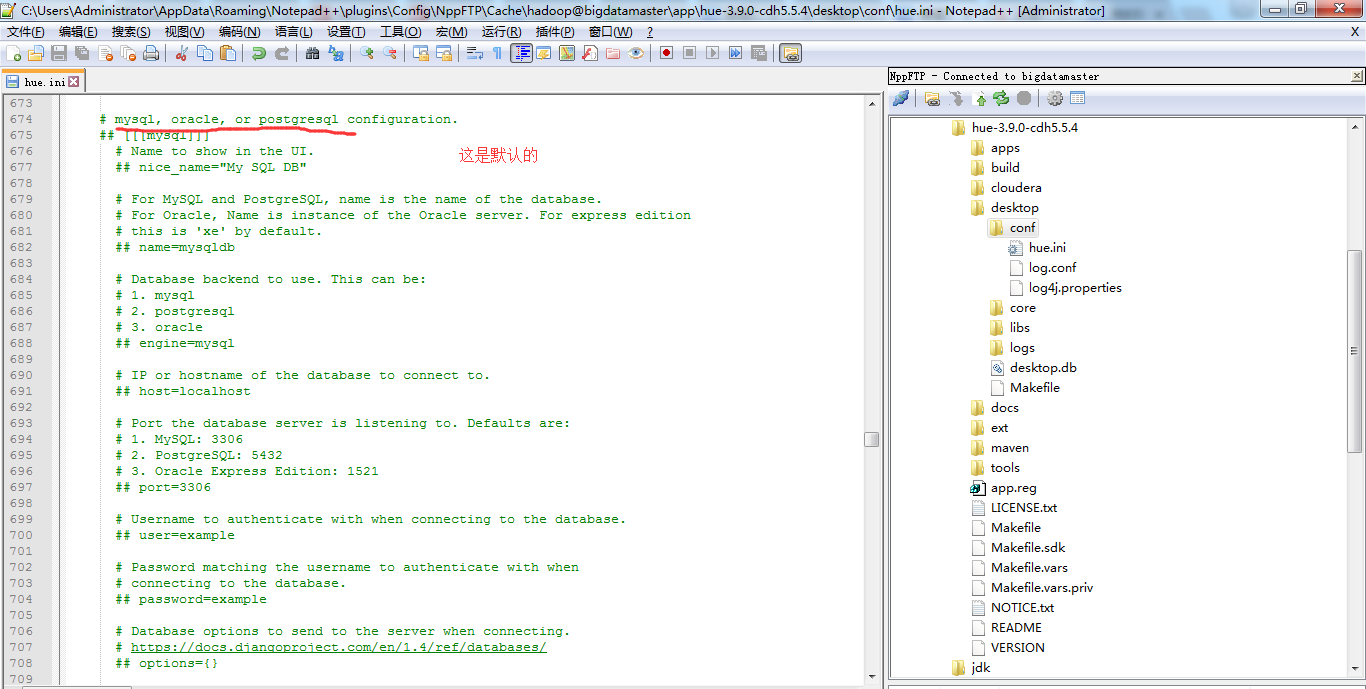
########################################################################### # Settings for the RDBMS application ########################################################################### [librdbms] # The RDBMS app can have any number of databases configured in the databases # section. A database is known by its section name # (IE sqlite, mysql, psql, and oracle in the list below). [[databases]] # sqlite configuration. ## [[[sqlite]]] # Name to show in the UI. ## nice_name=SQLite # For SQLite, name defines the path to the database. ## name=/tmp/sqlite.db # Database backend to use. ## engine=sqlite # Database options to send to the server when connecting. # https://docs.djangoproject.com/en/1.4/ref/databases/ ## options={} # mysql, oracle, or postgresql configuration. ## [[[mysql]]] # Name to show in the UI. ## nice_name="My SQL DB" # For MySQL and PostgreSQL, name is the name of the database. # For Oracle, Name is instance of the Oracle server. For express edition # this is 'xe' by default. ## name=mysqldb # Database backend to use. This can be: # 1. mysql # 2. postgresql # 3. oracle ## engine=mysql # IP or hostname of the database to connect to. ## host=localhost # Port the database server is listening to. Defaults are: # 1. MySQL: 3306 # 2. PostgreSQL: 5432 # 3. Oracle Express Edition: 1521 ## port=3306 # Username to authenticate with when connecting to the database. ## user=example # Password matching the username to authenticate with when # connecting to the database. ## password=example # Database options to send to the server when connecting. # https://docs.djangoproject.com/en/1.4/ref/databases/ ## options={}
二、以下是跟我机器集群匹配的配置文件(非HA集群下怎么配置Hue的database模块)
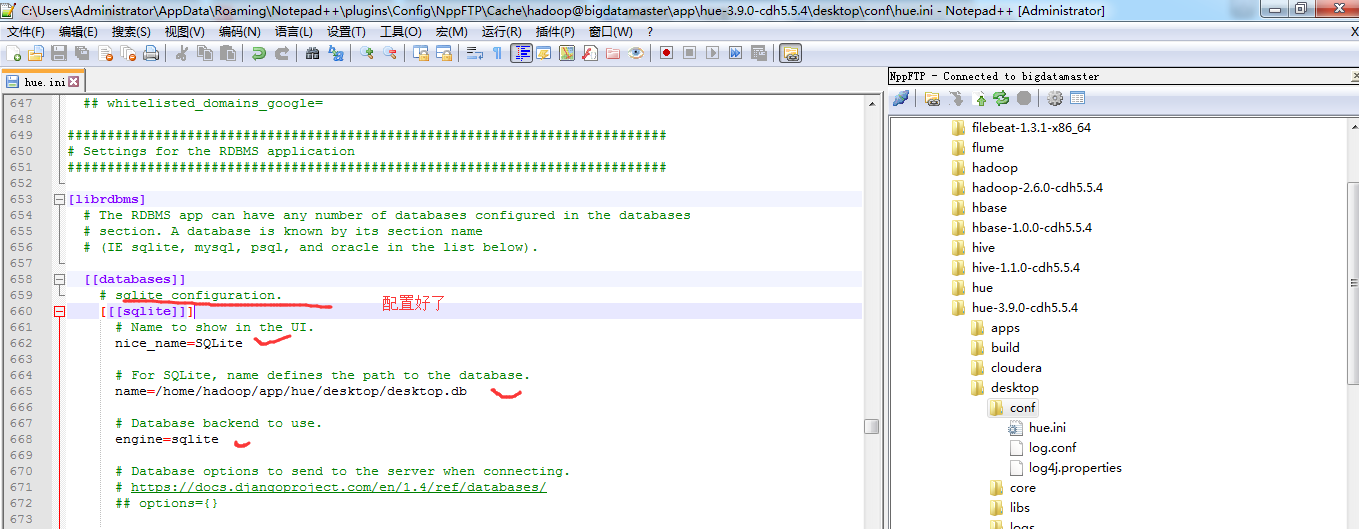
########################################################################### # Settings for the RDBMS application ########################################################################### [librdbms] # The RDBMS app can have any number of databases configured in the databases # section. A database is known by its section name # (IE sqlite, mysql, psql, and oracle in the list below). [[databases]] # sqlite configuration. [[[sqlite]]] # Name to show in the UI. nice_name=SQLite # For SQLite, name defines the path to the database. name=/home/hadoop/app/hue/desktop/desktop.db # Database backend to use. engine=sqlite
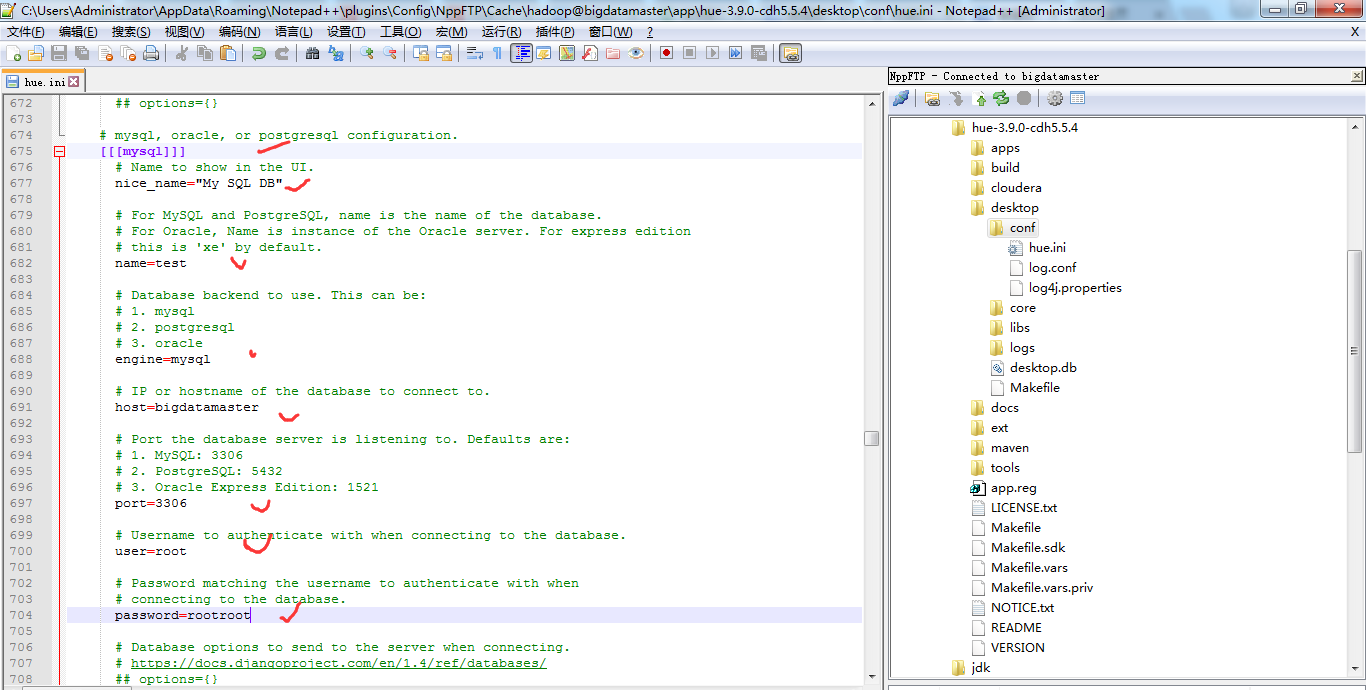
# mysql, oracle, or postgresql configuration. [[[mysql]]] # Name to show in the UI. nice_name="My SQL DB" # For MySQL and PostgreSQL, name is the name of the database. # For Oracle, Name is instance of the Oracle server. For express edition # this is 'xe' by default. name=test # Database backend to use. This can be: # 1. mysql # 2. postgresql # 3. oracle engine=mysql # IP or hostname of the database to connect to. host=bigdatamaster # Port the database server is listening to. Defaults are: # 1. MySQL: 3306 # 2. PostgreSQL: 5432 # 3. Oracle Express Edition: 1521 port=3306 # Username to authenticate with when connecting to the database. user=root # Password matching the username to authenticate with when # connecting to the database. password=rootroot # Database options to send to the server when connecting. # https://docs.djangoproject.com/en/1.4/ref/databases/ ## options={}
当然,这里,也可以用hive里安装的mysql里的数据库hive(命名)。(我一般用这种)
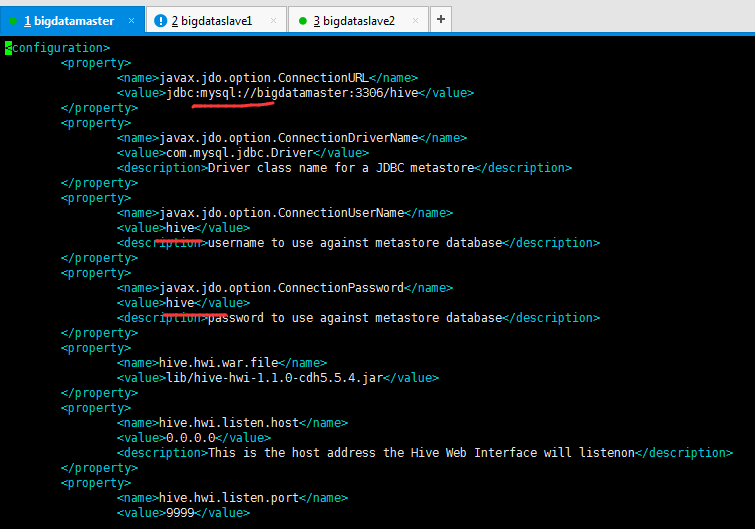
hive> show databases; OK default hive Time taken: 0.074 seconds, Fetched: 2 row(s) hive>

# mysql, oracle, or postgresql configuration. [[[mysql]]] # Name to show in the UI. nice_name="My SQL DB" # For MySQL and PostgreSQL, name is the name of the database. # For Oracle, Name is instance of the Oracle server. For express edition # this is 'xe' by default. name=hive # Database backend to use. This can be: # 1. mysql # 2. postgresql # 3. oracle engine=mysql # IP or hostname of the database to connect to. host=bigdatamaster # Port the database server is listening to. Defaults are: # 1. MySQL: 3306 # 2. PostgreSQL: 5432 # 3. Oracle Express Edition: 1521 port=3306 # Username to authenticate with when connecting to the database. user=hive # Password matching the username to authenticate with when # connecting to the database. password=hive # Database options to send to the server when connecting. # https://docs.djangoproject.com/en/1.4/ref/databases/ ## options={}
最后的界面,如下

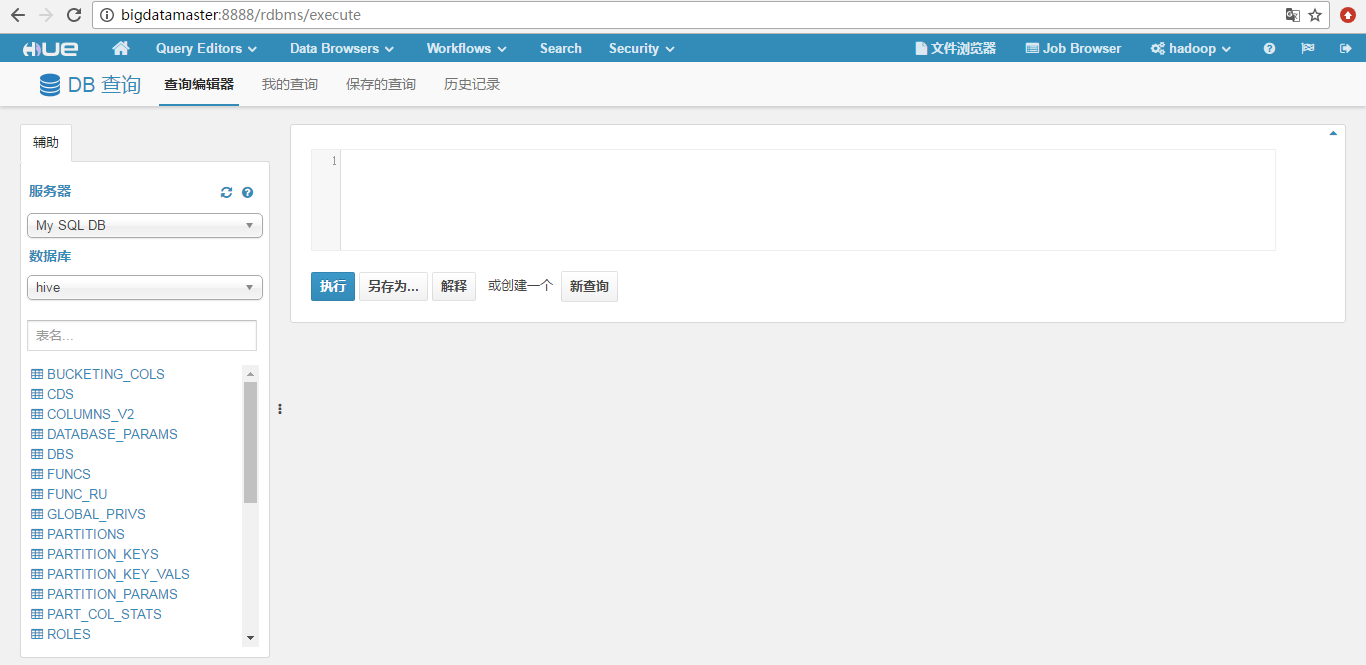
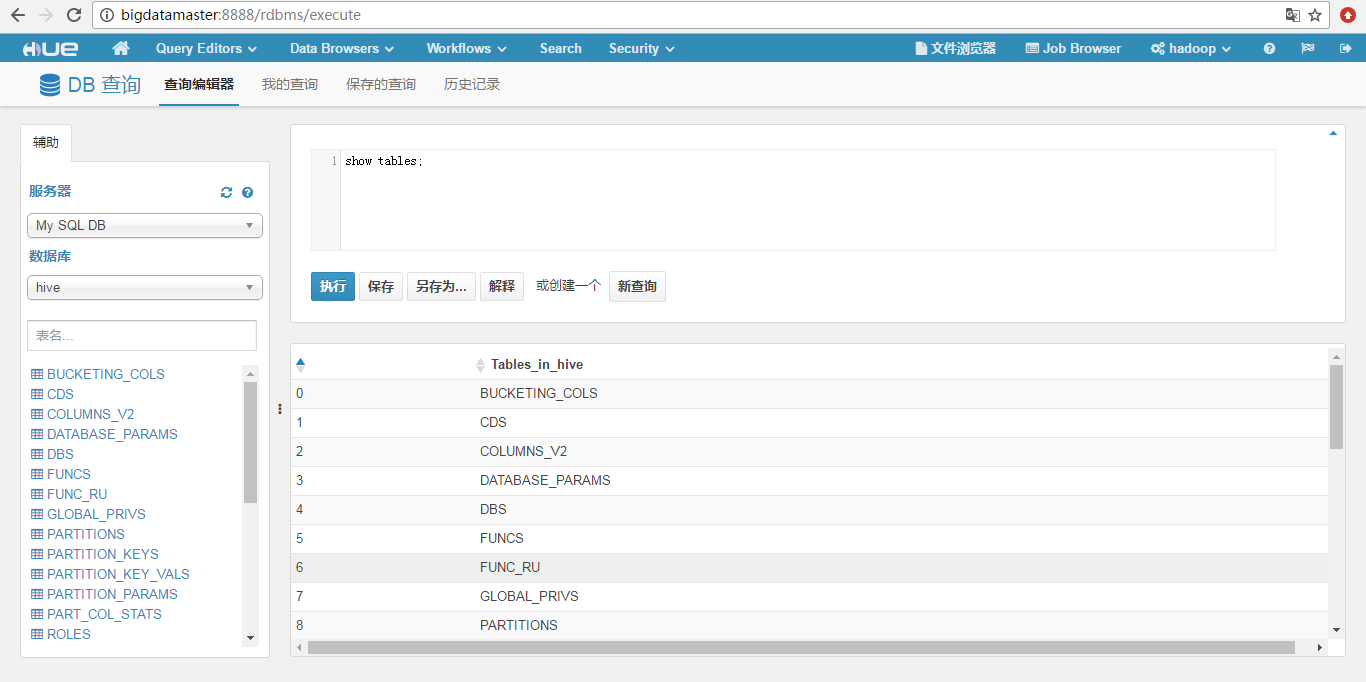
三、以下是跟我机器集群匹配的配置文件(HA集群下怎么配置Hue的database模块)

<configuration>
<property>
<name>javax.jdo.option.ConnectionURL</name>
<value>jdbc:mysql://bigdata-pro01.kfk.com:3306/metastore?createDatabaseIfNotExist=true</value>
</property>
<property>
<name>javax.jdo.option.ConnectionDriverName</name>
<value>com.mysql.jdbc.Driver</value>
</property>
<property>
<name>javax.jdo.option.ConnectionUserName</name>
<value>root</value>
</property>
<property>
<name>javax.jdo.option.ConnectionPassword</name>
<value>root</value>
</property>
<property>
<name>hive.cli.print.header</name>
<value>true</value>
<description>Whether to print the names of the columns in query output.</description>
</property>
<property>
<name>hive.cli.print.current.db</name>
<value>true</value>
<description>Whether to include the current database in the Hive prompt.</description>
</property>
<property>
<name>hbase.zookeeper.quorum</name>
<value>bigdata-pro01.kfk.com,bigdata-pro02.kfk.com,bigdata-pro03.kfk.com</value>
</property>
</configuration>
所以,我这里设置如下:
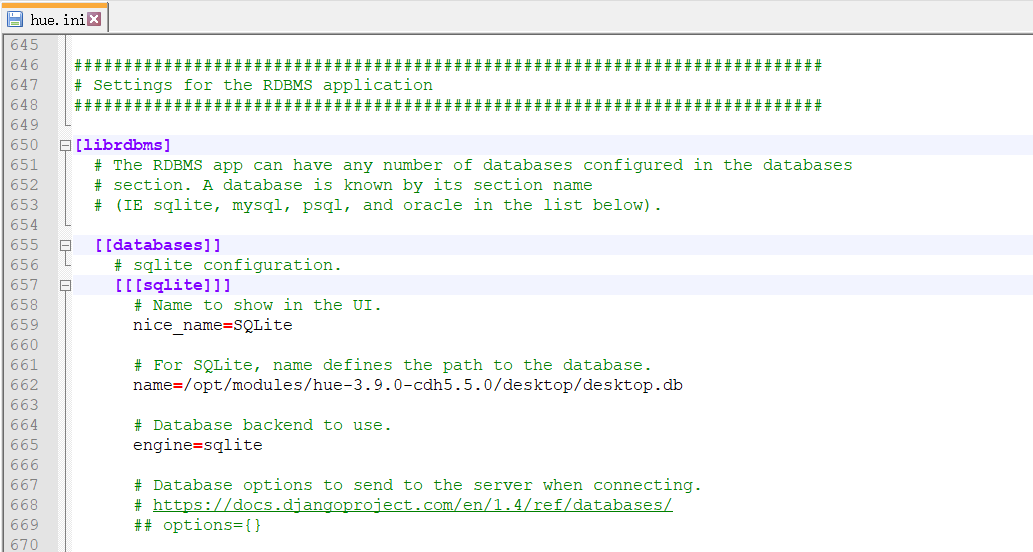
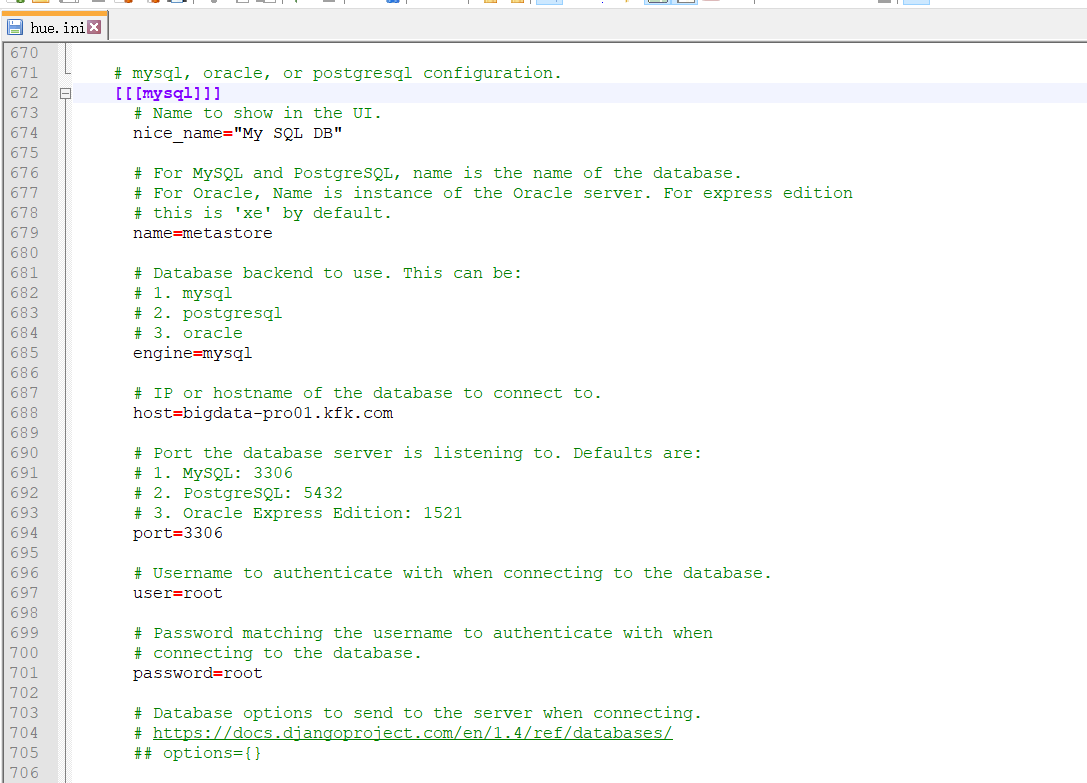
########################################################################### # Settings for the RDBMS application ########################################################################### [librdbms] # The RDBMS app can have any number of databases configured in the databases # section. A database is known by its section name # (IE sqlite, mysql, psql, and oracle in the list below). [[databases]] # sqlite configuration. [[[sqlite]]] # Name to show in the UI. nice_name=SQLite # For SQLite, name defines the path to the database. name=/opt/modules/hue-3.9.0-cdh5.5.0/desktop/desktop.db # Database backend to use. engine=sqlite # Database options to send to the server when connecting. # https://docs.djangoproject.com/en/1.4/ref/databases/ ## options={} # mysql, oracle, or postgresql configuration. [[[mysql]]] # Name to show in the UI. nice_name="My SQL DB" # For MySQL and PostgreSQL, name is the name of the database. # For Oracle, Name is instance of the Oracle server. For express edition # this is 'xe' by default. name=metastore # Database backend to use. This can be: # 1. mysql # 2. postgresql # 3. oracle engine=mysql # IP or hostname of the database to connect to. host=bigdata-pro01.kfk.com # Port the database server is listening to. Defaults are: # 1. MySQL: 3306 # 2. PostgreSQL: 5432 # 3. Oracle Express Edition: 1521 port=3306 # Username to authenticate with when connecting to the database. user=root # Password matching the username to authenticate with when # connecting to the database. password=root # Database options to send to the server when connecting. # https://docs.djangoproject.com/en/1.4/ref/databases/ ## options={}
然后,关闭mysql,再重启mysql,重启一下hue。
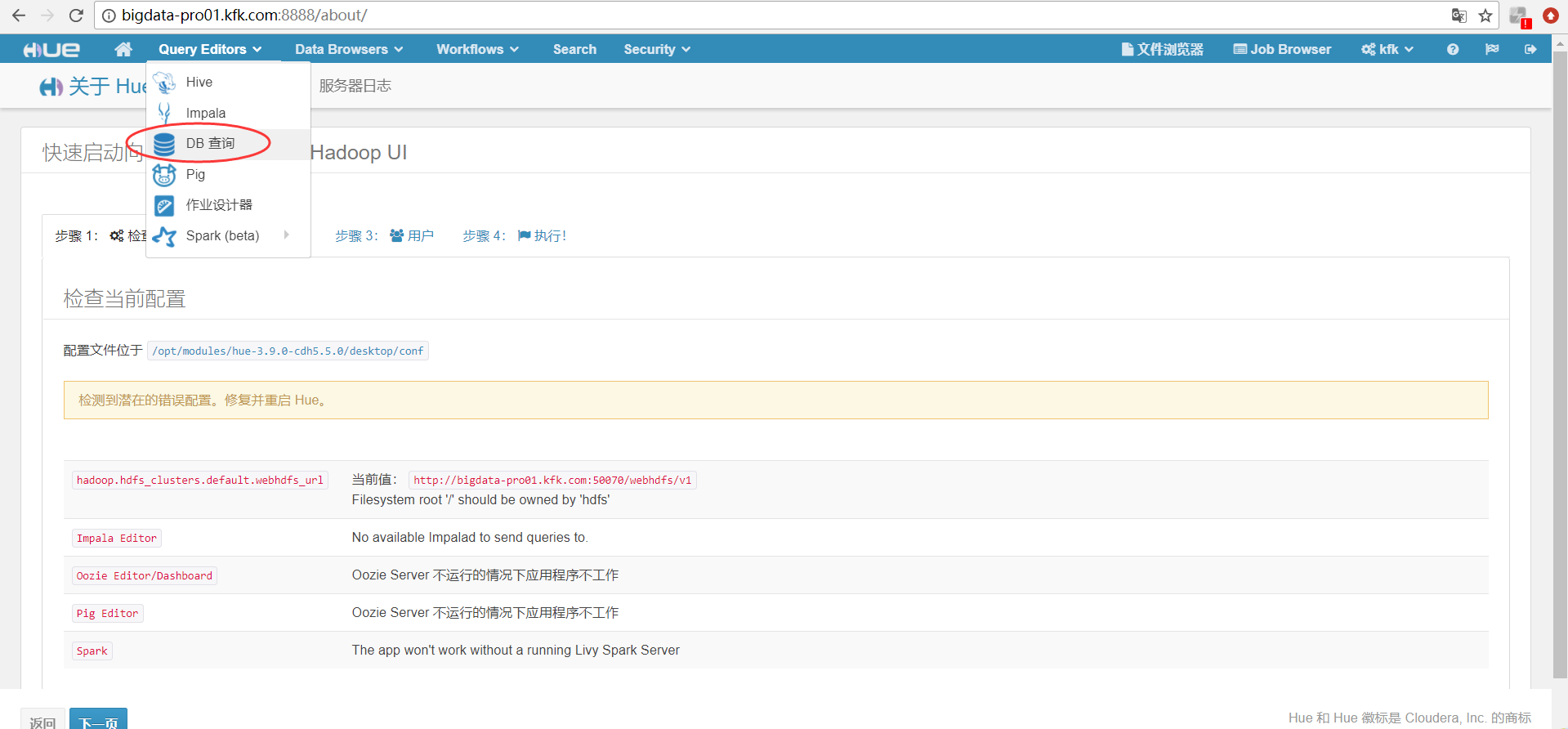
再,停掉mysql,重启mysql和hue

[kfk@bigdata-pro01 conf]$ sudo service mysqld restart
Stopping mysqld: [ OK ]
Starting mysqld: [ OK ]
[kfk@bigdata-pro01 conf]$

[kfk@bigdata-pro01 hue-3.9.0-cdh5.5.0]$ ./build/env/bin/supervisor
[INFO] Not running as root, skipping privilege drop
starting server with options:
{'daemonize': False,
'host': 'bigdata-pro01.kfk.com',
'pidfile': None,
'port': 8888,
'server_group': 'hue',
'server_name': 'localhost',
'server_user': 'hue',
'ssl_certificate': None,
'ssl_cipher_list': 'ECDHE-RSA-AES128-GCM-SHA256:ECDHE-ECDSA-AES128-GCM-SHA256:ECDHE-RSA-AES256-GCM-SHA384:ECDHE-ECDSA-AES256-GCM-SHA384:DHE-RSA-AES128-GCM-SHA256:DHE-DSS-AES128-GCM-SHA256:kEDH+AESGCM:ECDHE-RSA-AES128-SHA256:ECDHE-ECDSA-AES128-SHA256:ECDHE-RSA-AES128-SHA:ECDHE-ECDSA-AES128-SHA:ECDHE-RSA-AES256-SHA384:ECDHE-ECDSA-AES256-SHA384:ECDHE-RSA-AES256-SHA:ECDHE-ECDSA-AES256-SHA:DHE-RSA-AES128-SHA256:DHE-RSA-AES128-SHA:DHE-DSS-AES128-SHA256:DHE-RSA-AES256-SHA256:DHE-DSS-AES256-SHA:DHE-RSA-AES256-SHA:AES128-GCM-SHA256:AES256-GCM-SHA384:AES128-SHA256:AES256-SHA256:AES128-SHA:AES256-SHA:AES:CAMELLIA:DES-CBC3-SHA:!aNULL:!eNULL:!EXPORT:!DES:!RC4:!MD5:!PSK:!aECDH:!EDH-DSS-DES-CBC3-SHA:!EDH-RSA-DES-CBC3-SHA:!KRB5-DES-CBC3-SHA',
'ssl_private_key': None,
'threads': 40,
'workdir': None}
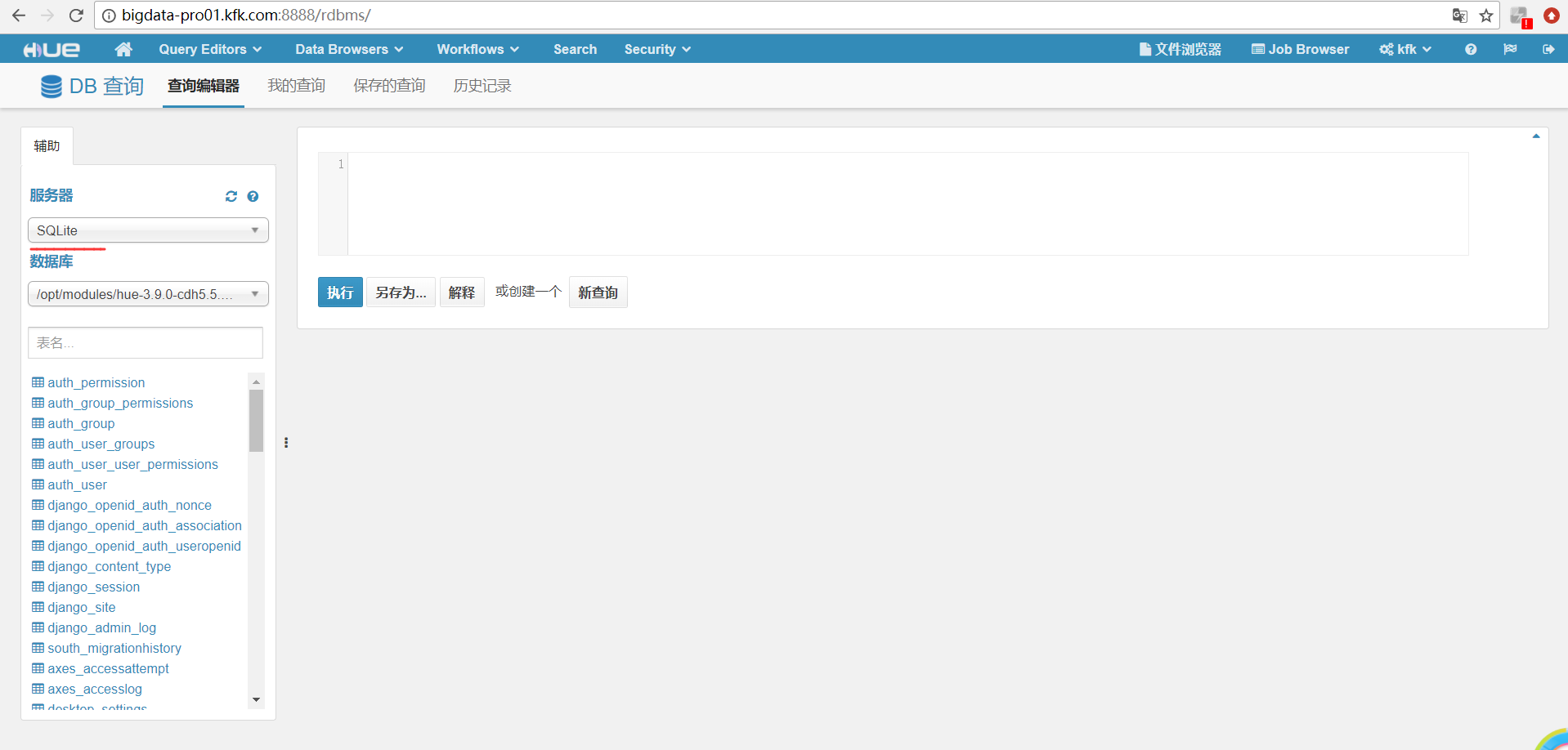

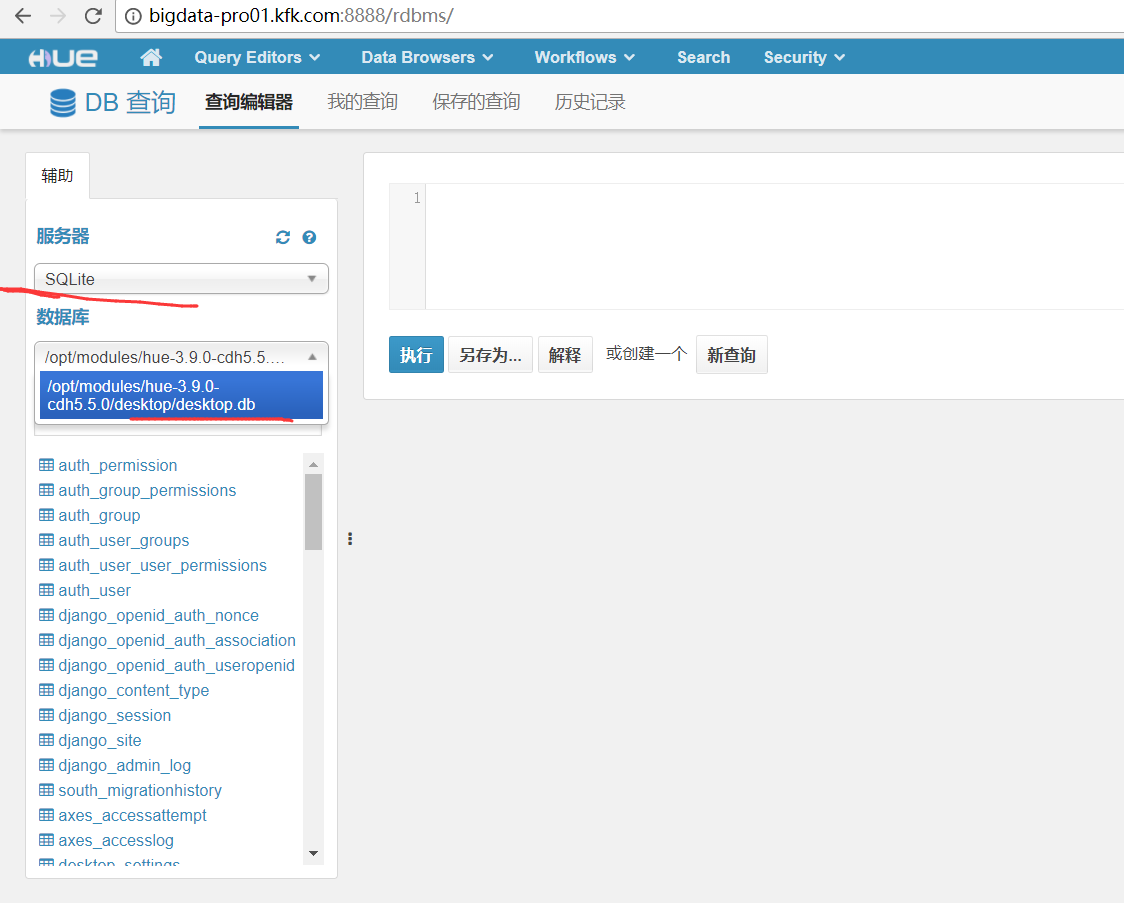

总结:
即,Hue的服务器(名字为My SQL DB,一般是mysql, oracle, or postgresql)。通常用mysql。
那么,它的数据库是metastore,是在hive里新建的mysql来充当它的元数据库。
<property>
<name>javax.jdo.option.ConnectionURL</name>
<value>jdbc:mysql://master:3306/metastore?createDatabaseIfNotExist=true</value>
</property>
Hue的服务器(名字为SQLite),那么它的数据库是/opt/modules/hue-3.9.0-cdh5.5.0/desktop/desktop.db
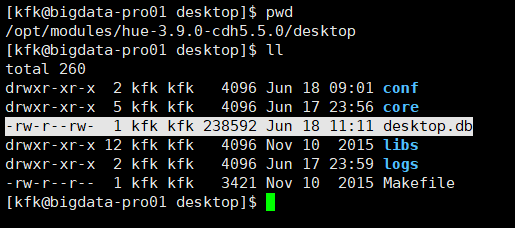
同时,大家可以关注我的个人博客:
http://www.cnblogs.com/zlslch/ 和 http://www.cnblogs.com/lchzls/ http://www.cnblogs.com/sunnyDream/
详情请见:http://www.cnblogs.com/zlslch/p/7473861.html
人生苦短,我愿分享。本公众号将秉持活到老学到老学习无休止的交流分享开源精神,汇聚于互联网和个人学习工作的精华干货知识,一切来于互联网,反馈回互联网。
目前研究领域:大数据、机器学习、深度学习、人工智能、数据挖掘、数据分析。 语言涉及:Java、Scala、Python、Shell、Linux等 。同时还涉及平常所使用的手机、电脑和互联网上的使用技巧、问题和实用软件。 只要你一直关注和呆在群里,每天必须有收获
对应本平台的讨论和答疑QQ群:大数据和人工智能躺过的坑(总群)(161156071)






